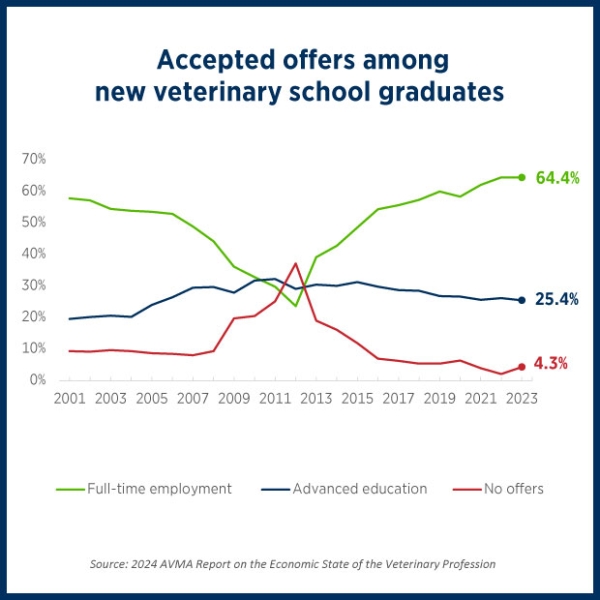The VCPR: Why it needs to be established in person
It’s all about protecting animal health and safety and public health
As telemedicine appointments become more common in veterinary medicine, some states are moving toward allowing the veterinarian-client-patient relationship (VCPR) to be established virtually, without a previous in-person examination of the animal or visit to the premises where the animals are kept. The AVMA opposes a VCPR being established virtually because it creates serious risks for patient health and safety.
Simply put, establishing the VCPR with an in-person, hands-on examination is in the best interest of animals and is fundamental to quality care. The veterinary profession has been using telemedicine successfully for a very long time, largely because it has been done within a VCPR established via an in-person exam or premise visit.
Foregoing an in-person exam threatens animal health
Diagnosing and treating an animal without previously having had an in-person visit is dangerous for animals’ health and welfare.
The initial in-person examination provides veterinarians with crucial information about both the animal and the owner. During a physical examination, the veterinarian uses sight, sound, touch, and smell to gather information about the animal’s physical condition. An in-person visit also allows the veterinarian to run any necessary diagnostic tests. Plus, the veterinarian learns about what the animal owner is comfortable doing with and for the animal.
All of this information is critical for a prompt and accurate diagnosis and an effective treatment plan. While the owner’s observations are an important piece of information for the veterinarian, they can be incomplete or inaccurate. Owners also may miss signs of disease, for example believing some signs like bad breath or smelly skin/ears to be normal. Without that in-person encounter, there’s a greater chance of a wrong or delayed diagnosis and/or a treatment plan that the owner can’t actually follow.
This is particularly dangerous in patients with atypical or nonspecific signs, where only a hands-on physical exam and/or diagnostic tests may reveal a medical emergency—for example, a severely distended bladder, enlarged uterus, or gastrointestinal obstruction.
Imagine this scenario:
A cat’s owner sees that it is lethargic and has a reduced appetite, but has seen no signs of pain (which cats are so good at hiding!) and doesn’t realize the cat swallowed some string. Without an in-person exam, the veterinarian can ask questions to get a better idea of what’s going on, but the true cause might be overlooked. A hands-on exam might reveal a string wrapped around the base of the tongue, abdominal pain, and bunching of the intestines, prompting X-rays that show the classic “string-of-pearls” appearance to the intestines that can come from swallowed string. The in-person exam enables an accurate, quick diagnosis—potentially saving this cat’s life.
Another high-risk scenario involves any animal with a highly infectious disease like canine distemper or African swine fever, or a disease that threatens public health, such as rabies. Here, a missed or delayed diagnosis could have devastating, potentially large-scale consequences for other animals and people.
Expanding access to high-quality care
One of the claims in support of allowing a VCPR to be established virtually is that doing so will improve animals’ access to care—that more animals will be seen by veterinarians. But there’s no evidence that this is the case. In reality, animals that aren’t already getting regular preventive care are the ones most likely to have conditions that require an in-person exam to diagnose and treat.
As AVMA’s president, Dr. Rena Carlson, said recently in an article in Today’s Veterinary Business:
“Let’s be realistic. Often, when people talk about access to care, their thoughts go to basic care. The basic care most animals need is preventive care tailored to an animal’s specific circumstances. That requires an in-person visit.
“Unfortunately, animals that don’t regularly see a veterinarian are highly likely to need care that requires a complete physical examination to diagnose and treat. A wrong diagnosis or inappropriate treatment plan do not improve access to care. Instead, delays in diagnosis and effective treatment result in prolonged illness and suffering, and they cost the animal’s owner more.”
Telemedicine, yes—After a relationship is established in person
Proper use of telemedicine can improve effectiveness and efficiency in delivering veterinary care. It can help elevate patient care, provide convenience to owners, and benefit veterinary teams and practices. That’s why the AVMA provides a suite of resources that empower veterinary practices to implement telemedicine.
But telemedicine alone cannot replace an in-person examination. Establishing the VCPR in person gives the veterinarian important information about the animal’s physical condition and allows the veterinarian to obtain appropriate diagnostic specimens. And it provides the basis for a strong, collaborative relationship between the owner and the veterinary team.
In the past year, the AVMA has vigorously opposed legislative efforts to remove or relax the in-person VCPR requirement in numerous states. We will continue to do so. Forgoing the initial in-person examination puts the health and safety of animals at risk, as well as public health, and will increase the cost of care when animals receive a wrong diagnosis and treatment plan.
No one cares more about animals’ health and welfare than the AVMA and the more than 100,000 AVMA member veterinarians who have taken an oath to serve them. This is why we are committed to the in-person VCPR.




Comments
VCPR
How is each animal being seen individually going to serve production agriculture in veterinarian-short rural areas with large populations of food animals raised under a uniform production system where regular visits are frequently accomplished by trained lay service technicians reporting to company veterinarians usually board-certified in the appropriate specialty?
Certainly the complexities of companion animal care with clients and animals of widely varying rearing and presenting conditions appearing at infrequent intervals requires the approach described in the article, however, this limited approach leaves the differences involved in servicing production medicine unaddressed.
RE: VCPR
Hello Dr. Gonder, thank you for reaching out. To clarify - for larger groups of animals, a veterinarian-client-patient relationship (VCPR) is established with a visit to the premises where the animals are kept.
Virtual VCPR
Thank you for watching out for the best interest of our patients, clients and profession on this issue!
Thank you for your stance on in-person VPCR
It is even more crucial for animals to establish an in-person VPCR. People can speak, letting providers know if something hurts, if they feel a heart "flutter", GI upset, etc. I cannot hear a heart murmur, an arrhythmia, raspy lungs sounds, or as you said, an extended bladder without seeing the pet in person. The mega corporations have politicians in their pockets. Please do whatever you can to discourage this harmful practice.
Telehealth
The example you cited for discouraging telemedicine is as follows;
"A cat’s owner sees that it is lethargic and has a reduced appetite, but has seen no signs of pain (which cats are so good at hiding!) and doesn’t realize the cat swallowed some string. Without an in-person exam, the veterinarian can ask questions to get a better idea of what’s going on, but the true cause might be overlooked. A hands-on exam might reveal a string wrapped around the base of the tongue, abdominal pain, and bunching of the intestines, prompting X-rays that show the classic “string-of-pearls” appearance to the intestines that can come from swallowed string. The in-person exam enables an accurate, quick diagnosis—potentially saving this cat’s life."
The veterinarian is still responsible for taking this telehealth consultation and deciding if the pet needs to be seen in person. This case clearly requires an in-hospital visit just on the symptoms. A string under the tongue is usually diagnosed after the pet has not been eating and vomiting. Any veterinarian providing telemedicine consultation should be responsible for deciding if the symptoms are reasonably diagnosed and treatable with telemedicine. Their veterinary license and malpractice should also be considered.
It is difficult for our clients to bring their nervous pets into the hospital. It is difficult for clients to drive a long distance to get professional advice in rural areas. 90% of the hospital visits are for the same 3-6 ailments that could at least be triaged via telemedicine. Statistically 50% of the problems are resolved by this method of veterinary care.
The average transaction fee is significantly less, which appears why there is such a pushback against this. This venue for treating animals is right but not as profitable. The clients will come to trust us more and have more dollars for their pets' care in their budget when their pet gets sick and needs to be seen in the hospital.
Standing against it for financial reasons is wrong. Holding the practitioner liable for deciding if the problem can be helped with telemedicine is right and should be enforced. The practitioner responsible in the scenario can not diagnose or provide medicine for a cat with anorexia, and certainly not vomiting via telemedicine. If they were to do so would be wrong and subjected to discipline.
AI and telemedicine will happen, soon, no matter how hard we push back. It works and it is the right thing to explore and put limitations to it. Let's control the use of it, not try to ban it.
Add New Comment